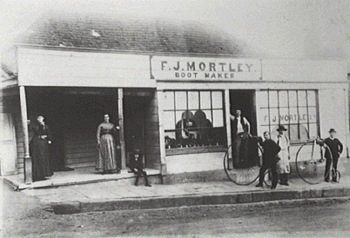Brief Outline of the Hawkesbury's Economy
The economy in the Hawkesbury district was based on agriculture and to a lesser extent, manufacturing. Some local identities demonstrated perceptive insights and commenced ventures that flourished, such as boat building, tanneries, meatworks, breweries, flour mills and wineries. The cultivation of wheat, maize, oats, vegetable & fruit production plus timber, dairying & poultry were important to the development of the district.
Manufacturing commenced early in the Hawkesbury with the processing of crops such as milling. Boatbuilding and brewing were other important industries in the during the 19th century. Settlers involved in the early shipbuilding industry along the Hawkesbury River included James Webb, Andrew Thompson, Jonathan Griffiths, Charles Beasley, William Grono & Alexander Books. With a good supply of timber boats of various sizes were constructed. It was reported in the Sydney Gazette, 21st July 1810 : "On Saturday last came around from Hawkesbury where she was built, the new schooner 'Elizabeth & Mary'. Messrs Griffiths and Thorley owners. She was launched at Richmond Hill about a month since, and brings a cargo of maize. Her burthen is about 80 tons, her keel 48 feet, 18 feet beam; and is considered to be one of the handsomest vessels ever built in the colony".
Up until the late 19th century boats up to 100 tonnes could dock at the Windsor Wharf, however due to the serious silting of the Hawkesbury River as a result of years of flooding, only smaller vessels could reach the wharf. During the 1880s the Hawkesbury Steam Navigation Company was established with smaller vessels working co-operatively conveying goods. The 'S.S. Hawkesbury' was one of the first steam ships trading regularly along the river. During World War II, the river trade emerged as a lifeline to farmers along the river. Produce, passengers and goods were ferried along the Hawkesbury, Colo and Macdonald Rivers.
The tanning industry boomed quickly in the 19th Century in NSW & by the 1830s six tanneries were recorded in Windsor, 1 this was 10 percent of the State's total. By the 1870s this figure had doubled.2 Bootmakers set up businesses close to the leather supply and both Windsor & Richmond had numerous Shoe and Boot makers.

The Mortley Bootmakers store in George Street Windsor NSW in the 1890s.
Source : Hawkesbury City Council Library Service
Brewing was another significant business in the Hawkesbury. Andrew Thompson, a convict who arrived in 1792, and was given permission to set up a brewery business in 1806. He constructed a large brewery along South Creek which expanded until his untimely death in 1810. Two large establishments were Cadell's Brewery and the business of John O'Dell. Hotels have always been popular in the district, however in the 1840s it was reported "there were forty public houses in and around Windsor"
In the mid to late nineteenth century, the district was still flourishing, a small, but major country town. The railway line linked Richmond to Sydney in 1864, encouraging growth along the line and the river still played an important role in transporting goods to the markets.
Small businesses developed in the township dotted around the Hawkesbury, however the administration hubs were centred around Windsor & Richmond. The main streets of these towns have for nearly two centuries have been bustling with general stores, blacksmiths, speciality shops, offices, banks and hotels.
On the commercial side there has been growth and fluctuations. Issues such as transport, the river trade and floods have had their affects on the local industries. The Great Fire in 1874 which damaged major portions of George & Macquarie Streets in Windsor, destroyed three whole blocks of the town centre. This would have had serious repercussions on businesses, as few individuals had insurance in those days. Although the Hawkesbury had the great distinction of assisting the colony develop initially during early years, during the late nineteenth century the relevance of the Hawkesbury declined for a number of reasons including the expansion of other major centres.
The local district is still a major supplier of vegetables and fruit to the Sydney markets. Up until about fifty years ago almost a quarter of the State's citrus trees were located in the Hawkesbury.4 Eventually successions of major floods damaged many of the orchards and market gardens and more recently many farmers have turned to turf as an alternative.
Today the district is focused on encouraging sustainable economic and employment growth within the Hawkesbury district. The main features of the Hawkesbury's economy are related to tourism & hospitality, the RAAF Base, small business whilst agriculture and horticulture still contribute significantly. Larger businesses involving manufacturing in the area include : Speedo, Polarcup, Hanna Match and Memtec.

Water lifter used at the turn of the 20th Century to irrigate farms along the Hawkesbury River NSW.
Source : Hawkesbury City Council Library Service
Footnotes
1. Returns of manufactories, mills etc., SRNSW Loc. 4/7267
2. NSW Statistical Registers 1867, p. 107 & 1873 p.119.
3. Steele 1916, Early days of Windsor, p. 13
4. Barkley & Nichols 1994, Hawkesbury 1794-1994, p. 32